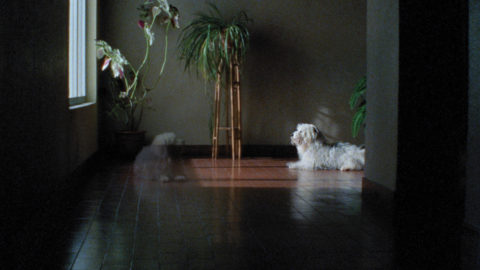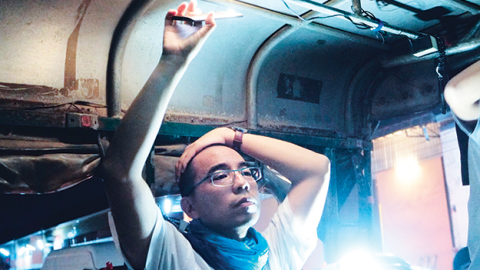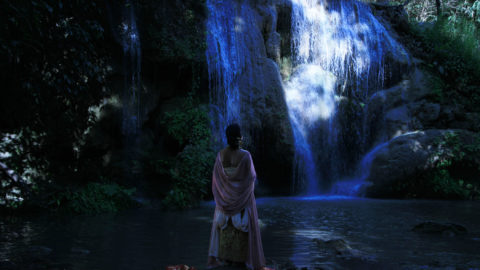Cannes Interview: Apichatpong Weerasethakul
Cemetery of Splendour, directed by Apichatpong Weerasethakul, screens September 30 and October 1 at The New York Film Festival. The below interview was conducted at Cannes shortly after the film’s world premiere.

At Cannes this year, it was hard not to raise an eyebrow at the strangely divergent pair of fates afforded two former Palme d’Or winners. Gus Van Sant, the top prize-winner in 2003 for Elephant, received one of the coveted slots in the main competition for his weepie Sea of Trees, starring Matthew McConaughey as a suicidal physics teacher. For Apichatpong Weerasethakul, however, the historic 2010 Palme for Uncle Boonmee Who Can Recall His Past Lives seemed to have been treated as an aberration, and his latest, Cemetery of Splendour, was tucked among the self-consciously global smorgasbord of Un Certain Regard.
Second-guessing and gossiping over the competition selection is a perennial pastime at the festival, but at the premiere, Apichatpong would have nothing of it. Introducing the film with characteristic grace, he said he was “honored to be among what’s considered the fresh voices of cinema” in Un Certain Regard, and thanked his partner, his growing “family” of collaborators, even his Twitter fans. And in a moment perhaps insufficiently noted, he saved a word for the strife in his home country of Thailand since the coup by royalist generals; that word was “terrible,” and it spoke volumes.
Like Apichatpong’s other films, Cemetery of Splendour is a multilayered, entrancing work of art, but its reception also highlights a danger with cinephilia that revels in the pleasures of the trance without recognizing a deeper anguish in the film. Set in and around an old-fashioned clinic in Khon Kaen—Apichatpong’s childhood hometown in northeast Thailand—the story follows a volunteer, Jenjira (Jenjira Pongpas Widmer), as she treats a soldier (Banlop Lomnoi) afflicted with sleeping sickness and befriends a younger psychic, Keng (Jarinpattra Rueangram). It’s a tale alive with the warmth of friendship, and the serendipity of dreams and spiritual discovery, but this is not a film about untroubled slumber.
It is possible, amidst the playful humor and the vibrant color brought forth by DP Diego Garcia, to see Thailand’s troubles poking through the surface of Cemetery of Splendour. Just as the film interweaves worlds of dream, reality, and animistic presence, so one could read into the clinic’s location (described as the site of past civil wars), the use of the Thai flag’s colors, or the portrait of a military dictator in the clinic’s canteen. Jenjira’s tour of the former grounds of a palace, in a forest decorated with slogan-like signs, feels like another rumination on the past and the present. One could even view the extraordinary climactic shot of Jenjira—eyes wide open—in terms of the symbolism of sight and blindness used by those not supportive of the country’s monarchy.
In any case, as Apichatpong affirmed in his Un Certain Regard introduction, his new film “is as personal as ever.” Part of that lies in Khon Kaen’s resonance as the place where his parents worked at a hospital and where he grew up; he looks at the city, he’s said, “with the eyes of sadness.” But as Apichatpong reckons with whether one can go back home again, the notion of home takes on ever greater poignancy and scope in a country that has experienced arduous, and deadly, change. At Cannes, FILM COMMENT spoke with the filmmaker about some of these conflicted emotions, soon after the premiere of Cemetery of Splendour.

You’ve said this is a very personal film. Could you talk about why it felt that way? Was it just that it was shot in Khon Kaen?
No, it was the first time I shot a movie there [in Khon Kaen], but it was personal more in the expression of hopelessness for me. It feels like living there [in Thailand], it is more and more difficult for me to express things, and to see friends being detained, being put in jail—almost like [I’m] waiting for my turn. But at the same time, I didn’t know that, in working with this fear, if I want to really make a movie—maybe not a movie, but any expression, an interview, an interview, or whatever—I have to censor myself. So I make this film that, I hope, expresses these feelings of not being in reality—in a state of not knowing what state one’s in, whether you are asleep or awake. And at the same time, you really want to know, you want to wake up.
This sounds like a bad sleep. In your previous films, it seemed as if sleep could more often be reflective. But this sounds like more of a negative sleep.
For me, yes. But my friends saw it, and they feel very sad, and some cried, but for others, and for me too, overall it’s pretty sunny. It’s really done with humor and quite playful in a way. But somehow, that’s how I feel in Thailand—that it’s pleasurable, but at the same time, there’s something underneath…
It feels that way in the movie too. You mentioned that you have friends who are in jail?
Yes. What happened was—with Facebook or with talking, writing, whatever—since the military took over the country in May last year, people are blacklisted and then asked to do attitude adjustment. So you go, and they won’t release you till you sign [an agreement] that you’re not going to engage in political activity. Otherwise, you will be prosecuted and your financial assets will be frozen. Two performance artists were put in jail for a year, two years, and they’re still there now. You don’t know much about this outside Thailand.
With your other films, I felt I could find my way into it, but yes, in this case I wondered what a Thai viewer might be seeing that I am not.
Well, there are some references. Some pictures pop up—like of past dictatorships or something like that. Little things.
Could you talk about the sequence in which Jenjira and Keng walk through the palace, or where a palace once stood?
I wanted to accentuate the nature of cinema that is illusion, but at the same time, there are also layers in life, how we choose to see, or not. Or how belief can really affect how we see. I’m sure when people look at the empty space and talk about this pink stone, I’m sure some people would try to imagine something there, or some bed with crocodile feet, something like that. Also at the same time, it reflects this belief in animist culture in Thailand: that we are living not only in the regular plane but also the spiritual plane. For me, I don’t believe in that, but the observation of this belief makes the culture very interesting—these layers of the indivisible. The trees and every object have other spirits, something that affects your life.
And then there are the goddesses who appear. Is that a separate belief from the animism?
It’s a bunch [of beliefs], like the whole of Hinduism, Buddhism, and animism…
Another moment where I felt I was missing something was the journal we see held in close-up on the screen.
I took it from a text of a woman whose husband died in prison because of one law that I am really against, because it’s barbaric and wrong. I don’t think her husband was given a fair trial, and bail was not granted. So he stayed there and died. And in his funeral, his wife released this diary about their time together mostly. It’s not political but…

It could be hard to make out its full meaning without subtitles.
It’s a tricky shot. It’s quite hard for the audience. Yes, that’s one thing that we cannot do in terms of Thai audiences and foreign audiences understanding. Dates are also important: also hidden on the blackboard [in the clinic, a former classroom] are important dates.
The title of the film was changed before its current incarnation as Cemetery of Splendour, because of concerns about the law of lèse-majesté. Could you talk about that?
Four years ago, when we came up with the film and started to raise funds, we used [another title], but after a few months, there was a lot of political heat. The coup happened, and it was really extreme. Many people were in jail, so we decided not to go in that way. Even though I talk about a different kingdom in the past in the film, the problem with this law is that anyone can charge you, someone in the street can charge you. So it’s been abused and used like a weapon.
How did the movie change for you as you were making it over the past few years?
During the development I really enjoyed writing with Jenjira in mind. In the end I made three movie treatments, three stories. So Simon [Field, producer] and I picked the one that we thought is realistic. But it was really smooth—it was the first time I worked in Khon Kaen, and I had a lot of support. Crazy smooth. It feels almost like when we made Syndromes and a Century. Smooth and precise. And I did it with Diego Garcia, the DoP, because my [regular] DoP [Sayombhu Mukdeeprom] was “stolen” by Miguel Gomes [to shoot Arabian Nights]. He promised to come back, but he would have come back like a month before the shoot, and I thought no, we need more preparation. Carlos Reygadas recommended this young guy, and I said, OK, let’s try it, and it was perfect. Diego worked very precisely, so for us, with the time we had, there was not much room for improvisation. It’s really according to the sun, the time. So improvisation happened during the rehearsal, and then we adapt.
How did you work on the film’s look with Garcia?
I mostly worked on composition and, also closely with the production designer, the shadow and light. thing was for him to watch all my films and then he understood. It’s my first long film to be shot on digital, so it’s different—you work a lot in the postproduction. In the production you make the best composition and also balance of the tone. And then we did quite intensely work with the postproduction, in terms of the weight: more saturation, and all these things you can do later.
Like when the screen went green?
Yes, that’s post. But that night with the light, the long shot, that’s really not much manipulation, it’s just their life. When we were in the room, we just ran the camera, and everyone was transfixed because it was so beautiful. You could watch forever.

Those dream lights above the beds?
Yes, I designed the lights with my designer, with LED lights and a program.
There’s a touch of science fiction to that.
It’s actually a sign for the next film. I’m more and more desperate to make a science fiction film, because I’ve been wanting to make one for so long. I wrote one treatment already, and it was too expensive. It was called Utopia. But now I think it’s better to do a cheap science fiction, like homemade….
That clinic was one of the things that held a personal significance, right? Was it like the school you went to when growing up?
Oh, it’s an old school. When I studied, my school wasn’t like that, but a typical school that you could see anywhere in the province. It’s uniform, even the length is the same. Even though I didn’t study in that kind of school, it reminds me of this typical school landscape, and it reminded me of my home. When I was young, until I was 15, I stayed in the house in the hospital, and the house is like that, wood. So it’s a combination of home, school, and hospital.
Many layers…
Like in the jungle, the forest. It’s like what your mind thinks.
Speaking of the jungle, could you talk about the signs posted on the trees that Jenjira passes there? They say things like “Time left unused…is the longest time” or “To forget is to forgive.” Are they common in parks?
Usually. Not parks, more in temples. Almost out of the Bangkok, we have these signs, and when we went to do location hunting for schools, there were always these signs. I started to remember how they had all this propaganda when I was going to school, or something that was moral, preaching. Also in the school set [in the film], you see these signs, but really small. But at night, when Jenjira walks and she reads one sign—that kind of sign that says to be a better human, you need to be disciplined—this kind of thing has really shaped the country. It’s become a really conservative country, very morally obsessed. And at the same time it’s become very violent. I look at the Facebook of some people who are really active. We call them ultra-conservative. On Facebook they get very violent toward people who don’t agree with them, almost like witch hunts. They curse and tell people to die. And on their page, they go to the temple and they pray and quote something good and meditate. It sickens me.

It’s a weird separation.
But it happened. It’s a land of absurdity.
But you didn’t have any problems making the movie there?
Only Syndromes. Uncle Boonmee got a Palme, so it’s okay, and that’s not political there. For this one, I don’t think I can release it unless I cut something out.
Are you going to still be living there for the future you can see now?
More and more, no. I feel sad because for sure it will affect what I love, which is film, my film, because the land, this craziness, inspired me so much.
Sometimes it gets too crazy.
Yes. It affects your daily life. You ask yourself, are you still an artist, if you cannot speak what you want to say?






